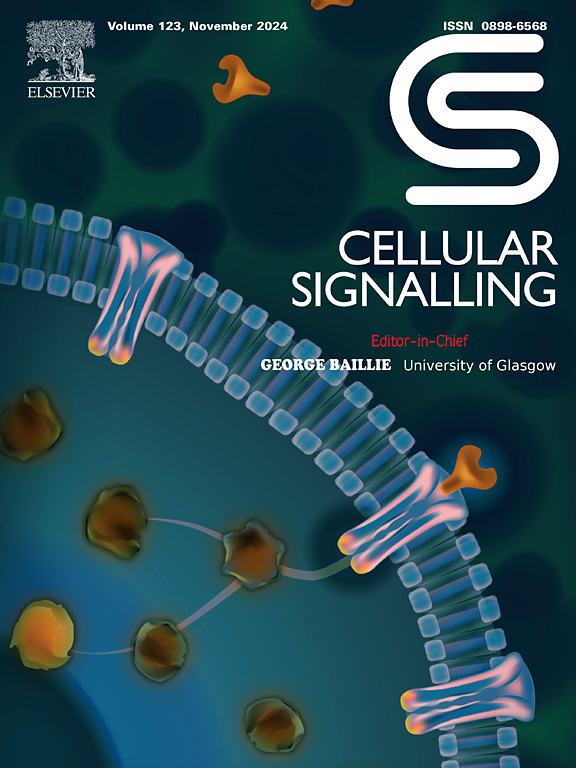CircHIPK3通过miR-10b-5p/DOHH/NF-κB轴调节骨水泥母细胞分化
IF 4.4
2区 生物学
Q2 CELL BIOLOGY
引用次数: 0
摘要
背景:完整的牙本质对牙齿的稳定和健康至关重要。牙根表面的骨水泥母细胞负责形成骨水泥膜。最近的证据表明,环状 RNA(circRNA)参与各种细胞功能,并可能具有临床应用价值。虽然 circHIPK3 已被证明参与了成骨过程,但其在骨水泥母细胞分化和矿化过程中的作用还不十分清楚:方法:利用桑格测序和放线菌素 D 试验证实了 circHIPK3 的环状结构。使用细胞核-细胞质分离试验评估了 circHIPK3 的亚细胞定位。利用 RT-qPCR 分析了骨水泥母细胞分化过程中和 TNF-α 处理后 circHIPK3 的表达。在体内,在小鼠下颌第一臼齿中诱发根尖周病变以模拟炎症环境,并评估 circHIPK3 的表达。通过RNA牵引实验、生物信息学分析和双荧光素酶报告实验探讨了circHIPK3/miR-10b-5p/DOHH轴的相互作用。通过测量成骨标志物、碱性磷酸酶(ALP)活性、ALP染色和茜素红S染色评估了对骨水泥母细胞分化和矿化的影响:结果:circHIPK3主要位于骨水泥母细胞的细胞质中,其表达在骨水泥母细胞分化过程中显著上调。敲除circHIPK3会抑制骨水泥母细胞的分化和矿化,而过表达则会促进这些过程。从机理上讲,circHIPK3通过疏导miR-10b-5p来上调DOHH的表达,从而促进骨水泥母细胞的分化和矿化。研究发现,在这些过程中,NF-κB通路作用于circHIPK3/miR-10b-5p/DOHH轴的下游。此外,在体外和体内的炎症环境中,circHIPK3的表达均显著下调。强制过表达 circHIPK3 可减轻 TNF-α 对骨水泥母细胞分化和矿化的抑制作用:结论:circHIPK3通过miR-10b-5p/DOHH/NF-κB轴作为骨水泥母细胞分化和矿化的正向调节因子,在正常和病理骨水泥生成过程中都起着至关重要的作用。本文章由计算机程序翻译,如有差异,请以英文原文为准。
CircHIPK3 regulates cementoblast differentiation via the miR-10b-5p/DOHH/NF-κB axis
Background
Intact cementum is vital for tooth stability and health. Cementoblasts, which line the root surface, are responsible for cementum formation. Recent evidence suggests that circular RNAs (circRNAs) are involved in various cellular functions and may have clinical applications. Although circHIPK3 has been shown to participate in osteogenesis, its role in cementoblast differentiation and mineralization is not well understood.
Methods
The ring structure of circHIPK3 was confirmed using Sanger sequencing and an actinomycin D assay. Subcellular localization of circHIPK3 was assessed using a nucleus-cytoplasm separation assay. RT-qPCR was employed to analyze circHIPK3 expression during cementoblast differentiation and following TNF-α treatment. In vivo, periapical lesions were induced in mouse mandibular first molars to mimic an inflammatory environment, and circHIPK3 expression was evaluated. The interaction of the circHIPK3/miR-10b-5p/DOHH axis was explored through RNA pull-down assays, bioinformatics analysis, and dual-luciferase reporter assays. The effects on cementoblast differentiation and mineralization were assessed by measuring osteogenic markers, alkaline phosphatase (ALP) activity, ALP staining, and alizarin red S staining.
Results
CircHIPK3 was predominantly located in the cytoplasm of cementoblasts, and its expression was significantly upregulated during cementoblast differentiation. Knockdown of circHIPK3 inhibited cementoblast differentiation and mineralization, whereas its overexpression promoted these processes. Mechanistically, circHIPK3 upregulated DOHH expression by sponging miR-10b-5p, thereby enhancing cementoblast differentiation and mineralization. The NF-κB pathway was found to act downstream of the circHIPK3/miR-10b-5p/DOHH axis in these processes. Additionally, circHIPK3 expression was significantly downregulated in inflammatory environments both in vitro and in vivo. Forced overexpression of circHIPK3 mitigated the inhibitory effects of TNF-α on cementoblast differentiation and mineralization.
Conclusion
CircHIPK3 acts as a positive regulator of cementoblast differentiation and mineralization through the miR-10b-5p/DOHH/NF-κB axis, playing a crucial role in both normal and pathological cementogenesis.
求助全文
通过发布文献求助,成功后即可免费获取论文全文。
去求助
来源期刊

Cellular signalling
生物-细胞生物学
CiteScore
8.40
自引率
0.00%
发文量
250
审稿时长
27 days
期刊介绍:
Cellular Signalling publishes original research describing fundamental and clinical findings on the mechanisms, actions and structural components of cellular signalling systems in vitro and in vivo.
Cellular Signalling aims at full length research papers defining signalling systems ranging from microorganisms to cells, tissues and higher organisms.
 求助内容:
求助内容: 应助结果提醒方式:
应助结果提醒方式:


